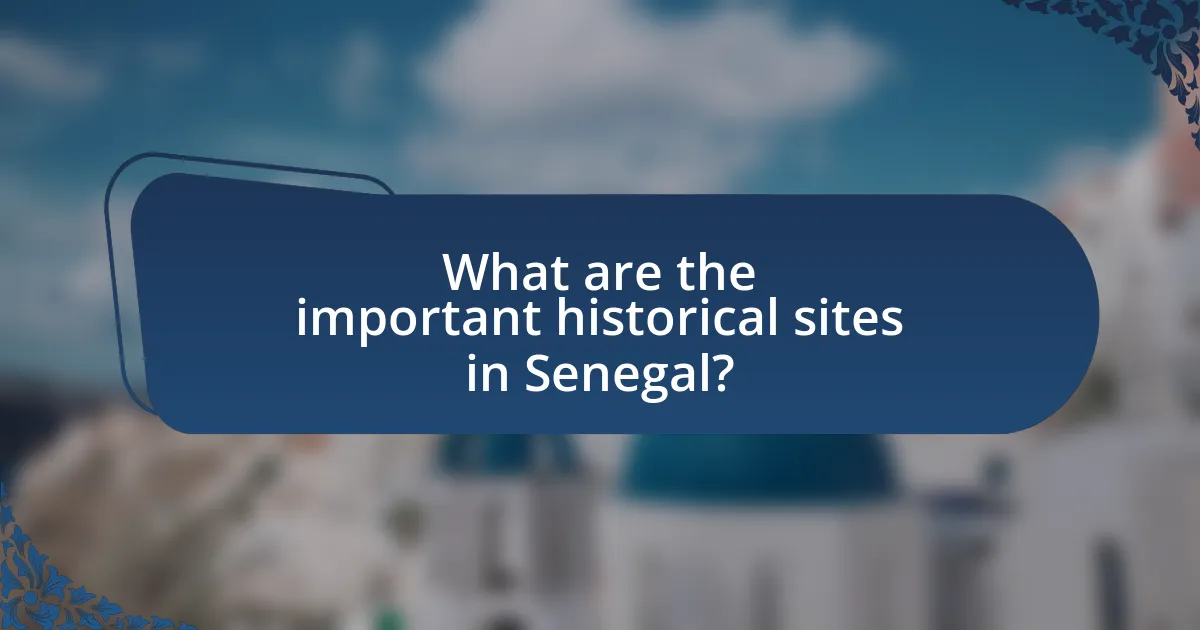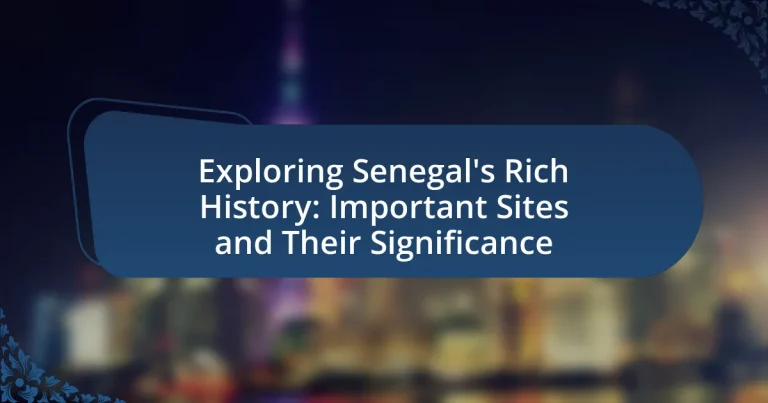Senegal’s rich history is characterized by its role as a cultural crossroads, a center for trade, and a significant player in the transatlantic slave trade, particularly through Gorée Island. The country was the first French colony in West Africa to gain independence in 1960, which marked a crucial moment in the decolonization of Africa. Key historical events, such as the establishment of French colonial rule and the emergence of influential leaders like Léopold Sédar Senghor, have shaped Senegal’s political and cultural identity. Important historical sites, including the House of Slaves and the African Renaissance Monument, serve as reminders of this complex past and contribute to the understanding of Senegal’s contemporary society. The article explores these significant sites, their historical importance, and how they reflect the diverse cultural heritage of Senegal.
What is the significance of Senegal’s history?
Senegal’s history is significant due to its role as a cultural crossroads and a center for trade, colonization, and independence movements in West Africa. The region was historically vital for the transatlantic slave trade, with Gorée Island serving as a major departure point for enslaved Africans. Additionally, Senegal was the first French colony in West Africa to gain independence in 1960, marking a pivotal moment in the decolonization of Africa. The country’s rich history is reflected in its diverse cultural heritage, including the influence of various ethnic groups, languages, and religions, which continue to shape its national identity today.
How has Senegal’s history shaped its cultural identity?
Senegal’s history has profoundly shaped its cultural identity through the influences of indigenous traditions, colonialism, and the transatlantic slave trade. The rich tapestry of Senegalese culture reflects the amalgamation of various ethnic groups, such as the Wolof, Serer, and Tukulor, each contributing unique customs, languages, and art forms. The impact of French colonial rule from the 17th century to independence in 1960 introduced European cultural elements, which blended with local practices, evident in Senegal’s music, cuisine, and festivals. Additionally, the legacy of the slave trade, particularly through sites like Gorée Island, has instilled a collective memory that informs contemporary Senegalese identity, emphasizing resilience and cultural pride. This historical context is crucial in understanding the vibrant cultural expressions found in Senegal today, such as the globally recognized music genre of mbalax and the annual Dakar Biennale, which showcase the country’s artistic heritage.
What key historical events have influenced Senegal’s development?
Key historical events that have influenced Senegal’s development include its role as a significant trading post during the transatlantic slave trade, the establishment of French colonial rule in the 19th century, and its subsequent independence in 1960. The transatlantic slave trade, which peaked in the 18th century, led to the forced migration of millions and shaped Senegal’s demographic and cultural landscape. French colonialism introduced new administrative structures and economic systems, impacting local governance and trade. Senegal’s independence marked a pivotal shift towards self-determination and nation-building, influencing its political and social frameworks. These events collectively shaped Senegal’s identity, economy, and political landscape, establishing a foundation for its contemporary development.
How do historical narratives contribute to Senegalese culture?
Historical narratives significantly contribute to Senegalese culture by shaping collective identity and preserving traditions. These narratives, rooted in the country’s history of resistance against colonialism and the rich tapestry of ethnic diversity, inform cultural practices, oral traditions, and social values. For instance, the stories of figures like Leopold Sedar Senghor, who emphasized the importance of African identity, have influenced Senegalese literature, music, and art, reinforcing a sense of pride and belonging among the populace. Additionally, historical sites such as Gorée Island serve as poignant reminders of the transatlantic slave trade, fostering a deeper understanding of the past and its impact on contemporary society. This interplay between history and culture ensures that Senegalese identity remains vibrant and resilient.
What are the major historical periods in Senegal?
The major historical periods in Senegal include the pre-colonial period, the colonial period, and the post-independence period. The pre-colonial period, characterized by the establishment of powerful kingdoms such as the Jolof Empire, lasted until the late 19th century. The colonial period began in the mid-19th century when France established control over Senegal, leading to significant social and economic changes. This period continued until Senegal gained independence in 1960, marking the beginning of the post-independence period, during which Senegal has developed as a sovereign nation, focusing on nation-building and democratic governance.
What role did pre-colonial societies play in Senegal’s history?
Pre-colonial societies in Senegal played a crucial role in shaping the region’s cultural, political, and economic landscape. These societies, including the Wolof, Serer, and Tukulor, established complex social structures and trade networks that facilitated interactions with neighboring regions and contributed to the development of urban centers like Dakar and Saint-Louis. Historical evidence shows that these societies engaged in agriculture, fishing, and trade, which laid the foundation for Senegal’s economy. Additionally, the establishment of kingdoms, such as the Jolof Empire, demonstrated sophisticated governance and social organization, influencing Senegal’s political history long before colonial rule.
How did colonialism impact Senegal’s social and political structures?
Colonialism significantly altered Senegal’s social and political structures by imposing foreign governance and disrupting traditional systems. The French colonial administration established a centralized authority that undermined local leadership and traditional power dynamics, leading to the erosion of indigenous governance systems. This shift was evident in the establishment of the French civil service, which marginalized local chiefs and replaced them with appointed officials loyal to the colonial regime. Additionally, colonial policies favored certain ethnic groups over others, exacerbating social divisions and creating a hierarchy that favored the French and their allies. The introduction of Western education and legal systems further transformed societal norms, leading to a gradual shift in cultural values and social organization. These changes laid the groundwork for future political movements and the eventual struggle for independence, as Senegalese leaders sought to reclaim autonomy and address the inequalities created during the colonial period.
What are the key historical figures in Senegal’s past?
Key historical figures in Senegal’s past include Leopold Sedar Senghor, who was the first president of Senegal and a prominent poet and philosopher, instrumental in promoting African identity and culture. Another significant figure is Aissatou Sow Sidibe, a feminist and activist who played a crucial role in advocating for women’s rights in Senegal. Additionally, Ousmane Sembene, known as the father of African cinema, contributed to the cultural landscape through his films and literature that addressed social issues. These figures have shaped Senegal’s political, cultural, and social history, reflecting the country’s rich heritage and ongoing evolution.
Who were the influential leaders during the independence movement?
The influential leaders during the independence movement in Senegal included Léopold Sédar Senghor, who became the first president of Senegal and played a crucial role in advocating for independence from French colonial rule. Senghor’s leadership was characterized by his promotion of African identity and culture, which he articulated through his philosophy of Négritude. Another key figure was Mamadou Dia, who served as the first Prime Minister of Senegal and was instrumental in the political negotiations leading to independence in 1960. These leaders were pivotal in shaping Senegal’s path to sovereignty and establishing its national identity.
What contributions did cultural figures make to Senegal’s history?
Cultural figures significantly shaped Senegal’s history through their contributions to literature, music, and political activism. Notably, Léopold Sédar Senghor, a poet and the first president of Senegal, played a crucial role in promoting the concept of Négritude, which celebrated African culture and identity, influencing post-colonial thought across the continent. Additionally, musicians like Youssou N’Dour have used their art to address social issues and promote national pride, while writers such as Mariama Bâ have highlighted women’s rights and social justice in their works. These contributions have not only enriched Senegal’s cultural landscape but also fostered a sense of national identity and unity.

What are the important historical sites in Senegal?
The important historical sites in Senegal include Gorée Island, the African Renaissance Monument, and the Great Mosque of Dakar. Gorée Island, a UNESCO World Heritage site, is significant for its role in the transatlantic slave trade, with the House of Slaves serving as a memorial to this dark chapter in history. The African Renaissance Monument, standing at 49 meters, symbolizes Senegal’s independence and progress since colonial rule. The Great Mosque of Dakar, one of the largest mosques in West Africa, showcases the country’s Islamic heritage and architectural grandeur. These sites collectively reflect Senegal’s rich cultural and historical narrative.
Which sites are recognized as UNESCO World Heritage Sites in Senegal?
Senegal is home to several UNESCO World Heritage Sites, including the Island of Gorée, the Ruins of the Great Mosque of Djenné, and the Saloum Delta. The Island of Gorée is recognized for its historical significance as a center of the transatlantic slave trade, while the Great Mosque of Djenné is noted for its unique mud-brick architecture and cultural importance. The Saloum Delta is acknowledged for its rich biodiversity and ecological significance. These sites collectively highlight Senegal’s cultural heritage and historical importance.
What makes Gorée Island significant in the context of slavery?
Gorée Island is significant in the context of slavery as it served as a major center for the transatlantic slave trade from the 15th to the 19th centuries. The island was a departure point for thousands of enslaved Africans who were forcibly taken to the Americas. Historical records indicate that Gorée Island housed various slave trading posts, including the infamous House of Slaves, which is now a museum and memorial. This site symbolizes the suffering endured by enslaved individuals and serves as a poignant reminder of the atrocities of slavery, making it a UNESCO World Heritage Site recognized for its historical importance.
How does the Island of Saint-Louis reflect colonial architecture?
The Island of Saint-Louis reflects colonial architecture through its well-preserved buildings that showcase French colonial design elements. The island features structures such as the Governor’s Palace and the old colonial houses, which exhibit neoclassical styles characterized by symmetrical facades, large windows, and decorative moldings. These architectural features are indicative of the French colonial influence during the 18th and 19th centuries when Saint-Louis served as the capital of French West Africa. The layout of the island, with its narrow streets and public squares, further emphasizes the colonial urban planning principles that prioritized control and administration.
What are other notable historical sites in Senegal?
Other notable historical sites in Senegal include the Island of Gorée, the African Renaissance Monument, and the Great Mosque of Dakar. The Island of Gorée, a UNESCO World Heritage site, served as a significant center for the transatlantic slave trade from the 15th to the 19th centuries, with the Maison des Esclaves (House of Slaves) being a poignant reminder of this history. The African Renaissance Monument, completed in 2010, stands as a symbol of African independence and unity, towering at 49 meters and representing the continent’s aspirations. The Great Mosque of Dakar, built in 1964, is an architectural landmark that reflects the Islamic heritage of Senegal and serves as a central place of worship for the Muslim community.
What is the historical importance of the African Renaissance Monument?
The African Renaissance Monument is historically important as it symbolizes Africa’s emergence from colonialism and its aspirations for unity and progress. Completed in 2010, the monument stands at 49 meters tall, making it the tallest statue in Africa, and represents a significant cultural and political statement for Senegal and the continent. It was designed by Senegalese architect Pierre Goudiaby Atepa and constructed to commemorate the 50th anniversary of Senegal’s independence, reflecting the nation’s pride and commitment to a future of self-determination and development. The monument also serves as a tourist attraction, contributing to Senegal’s economy and promoting African heritage on a global stage.
How does the House of Slaves contribute to understanding Senegal’s past?
The House of Slaves serves as a crucial historical site that enhances the understanding of Senegal’s past by illustrating the impact of the transatlantic slave trade. This site, located on Gorée Island, was a departure point for enslaved Africans, with estimates suggesting that over 20 million people were affected by this trade. The House of Slaves contains exhibits and memorials that document the experiences of those who were captured and sold into slavery, providing tangible evidence of the human suffering and cultural disruption caused by this historical atrocity. Additionally, the site has been recognized by UNESCO as a World Heritage Site, underscoring its significance in global history and its role in educating future generations about the consequences of slavery and colonialism.
How do these sites contribute to tourism in Senegal?
The historical sites in Senegal significantly contribute to tourism by attracting visitors interested in the country’s rich cultural heritage. For instance, sites like Gorée Island, recognized as a UNESCO World Heritage Site, draw attention due to their historical significance related to the transatlantic slave trade, with over 100,000 tourists visiting annually. Additionally, the vibrant architecture and museums in Dakar, such as the African Renaissance Monument, enhance the tourist experience by showcasing Senegal’s artistic and historical narratives. These sites not only provide educational value but also stimulate local economies through tourism-related activities, thereby reinforcing their importance in Senegal’s tourism sector.
What role do historical sites play in educating visitors about Senegal’s history?
Historical sites in Senegal serve as vital educational resources that inform visitors about the country’s rich history. These sites, such as Gorée Island, which was a significant center for the transatlantic slave trade, provide tangible connections to the past, allowing visitors to engage with historical narratives through preserved architecture and museums. For instance, the Maison des Esclaves on Gorée Island offers exhibits that detail the experiences of enslaved Africans, thereby enhancing understanding of the impact of slavery on Senegalese culture and identity. Additionally, sites like the Dakar Grand Mosque and the African Renaissance Monument illustrate the evolution of Senegalese society and its diverse influences, further enriching visitors’ knowledge of the nation’s historical context.
How can tourism at these sites support local communities?
Tourism at historical sites in Senegal can significantly support local communities by generating economic revenue and creating job opportunities. For instance, the presence of tourists leads to increased demand for local goods and services, which can boost small businesses such as restaurants, craft shops, and tour guides. According to a report by the World Bank, tourism can contribute up to 10% of a country’s GDP, highlighting its potential to enhance local economies. Additionally, tourism fosters cultural exchange and awareness, encouraging the preservation of local traditions and heritage, which can further strengthen community identity and cohesion.
How can one explore Senegal’s rich history effectively?
To explore Senegal’s rich history effectively, one should visit key historical sites such as Gorée Island, the House of Slaves, and the African Renaissance Monument. Gorée Island, recognized as a UNESCO World Heritage site, served as a significant center for the transatlantic slave trade, providing insight into the impact of slavery on Senegalese culture. The House of Slaves on the island offers a poignant representation of this history, showcasing artifacts and narratives that highlight the experiences of enslaved individuals. Additionally, the African Renaissance Monument, standing at 49 meters, symbolizes Africa’s progress and independence, reflecting Senegal’s modern historical context. Engaging with local historians and guided tours at these sites enhances understanding and appreciation of Senegal’s complex past.
What are the best practices for visiting historical sites in Senegal?
The best practices for visiting historical sites in Senegal include respecting local customs, engaging with guides, and preserving the integrity of the sites. Visitors should dress modestly, particularly when visiting religious or culturally significant locations, as this demonstrates respect for local traditions. Engaging with knowledgeable guides enhances the experience by providing context and historical significance, which is crucial for understanding sites like Gorée Island, known for its role in the transatlantic slave trade. Additionally, tourists should avoid touching artifacts or climbing on ruins to help preserve these important cultural heritage sites for future generations.
How can visitors prepare for a meaningful experience at these sites?
Visitors can prepare for a meaningful experience at Senegal’s historical sites by conducting thorough research on the cultural and historical significance of each location. Understanding the context of sites such as Gorée Island, known for its role in the transatlantic slave trade, enhances appreciation and engagement. Additionally, visitors should consider hiring local guides who can provide in-depth knowledge and personal stories, enriching the experience. Engaging with local communities and participating in cultural events can also deepen understanding and connection to the history.
What resources are available for learning about Senegal’s history before visiting?
Books, documentaries, and online resources are available for learning about Senegal’s history before visiting. Notable books include “A History of Senegal” by David Robinson, which provides a comprehensive overview of the country’s past, and “Senegal: A State of Mind” by Ousmane Sembène, which explores cultural narratives. Documentaries such as “Senegal: The Land of Teranga” offer visual insights into the nation’s heritage. Online platforms like UNESCO’s website provide access to historical data and cultural information, enhancing understanding of Senegal’s significance in West African history.
What are some recommended itineraries for exploring Senegal’s history?
To explore Senegal’s history, a recommended itinerary includes visiting Dakar, Gorée Island, Saint-Louis, and the historical sites in Kaolack. Start in Dakar, where the African Renaissance Monument and the Museum of Black Civilizations provide insights into Senegal’s cultural heritage. Next, take a ferry to Gorée Island, a UNESCO World Heritage site, known for its role in the transatlantic slave trade, featuring the House of Slaves museum. Proceed to Saint-Louis, the former capital during French colonial rule, where you can explore colonial architecture and the Faidherbe Bridge. Finally, visit Kaolack to see the regional history at the Kaolack Museum and the vibrant local markets, which reflect the historical trade routes of Senegal. This itinerary highlights significant historical sites and their cultural importance, providing a comprehensive understanding of Senegal’s rich history.
Which historical sites should be included in a week-long itinerary?
A week-long itinerary in Senegal should include the following historical sites: Goree Island, the House of Slaves, the African Renaissance Monument, Saint-Louis, and the Faidherbe Bridge. Goree Island, recognized as a UNESCO World Heritage site, served as a significant slave trading post, and the House of Slaves provides a poignant insight into this dark chapter of history. The African Renaissance Monument, standing at 49 meters, symbolizes Africa’s emergence from colonialism and is the tallest statue in Africa. Saint-Louis, the former capital of French West Africa, showcases colonial architecture and is also a UNESCO World Heritage site. The Faidherbe Bridge, completed in 1865, connects the island of Saint-Louis to the mainland and is an engineering marvel of its time. Each of these sites offers a unique perspective on Senegal’s rich historical narrative.
How can travelers balance historical exploration with cultural experiences?
Travelers can balance historical exploration with cultural experiences by integrating visits to historical sites with participation in local cultural activities. For instance, while exploring the Gorée Island, known for its historical significance in the transatlantic slave trade, travelers can also engage with local artisans and attend traditional music performances, which reflect Senegal’s vibrant culture. This dual approach allows for a deeper understanding of the historical context while appreciating the contemporary cultural expressions that stem from it. Engaging with local communities through guided tours or workshops further enhances this balance, providing insights into both the past and present of Senegalese life.





